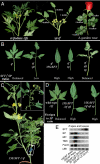The flowering hormone florigen functions as a general systemic regulator of growth and termination
- PMID: 19416824
- PMCID: PMC2688896
- DOI: 10.1073/pnas.0810810106
The flowering hormone florigen functions as a general systemic regulator of growth and termination
Abstract
The florigen paradigm implies a universal flowering-inducing hormone that is common to all flowering plants. Recent work identified FT orthologues as originators of florigen and their polypeptides as the likely systemic agent. However, the developmental processes targeted by florigen remained unknown. Here we identify local balances between SINGLE FLOWER TRUSS (SFT), the tomato precursor of florigen, and SELF-PRUNING (SP), a potent SFT-dependent SFT inhibitor as prime targets of mobile florigen. The graft-transmissible impacts of florigen on organ-specific traits in perennial tomato show that in addition to import by shoot apical meristems, florigen is imported by organs in which SFT is already expressed. By modulating local SFT/SP balances, florigen confers differential flowering responses of primary and secondary apical meristems, regulates the reiterative growth and termination cycles typical of perennial plants, accelerates leaf maturation, and influences the complexity of compound leaves, the growth of stems and the formation of abscission zones. Florigen is thus established as a plant protein functioning as a general growth hormone. Developmental interactions and a phylogenetic analysis suggest that the SFT/SP regulatory hierarchy is a recent evolutionary innovation unique to flowering plants.
Conflict of interest statement
The authors declare no conflict of interest.
Figures






References
-
- Chailakhyan MK. [About the mechanism of the photoperiodic response (in Russian)] Dokl Akad Nauk SSSR. 1936;1:85–89.
-
- Zeevaart JAD. Physiology of flower formation. Ann Rev Plant Phys. 1976;27:321–348.
-
- Kobayashi Y, Weigel D. Move on up, it's time for change—mobile signals controlling photoperiod-dependent flowering. Genes Dev. 2007;21:2371–2384. - PubMed
-
- Turck F, Fornara F, Coupland G. Regulation and identity of florigen: FLOWERING LOCUS T moves center stage. Ann Rev Plant Biol. 2008;59:573–594. - PubMed
Publication types
MeSH terms
Substances
LinkOut - more resources
Full Text Sources
Other Literature Sources
Molecular Biology Databases

